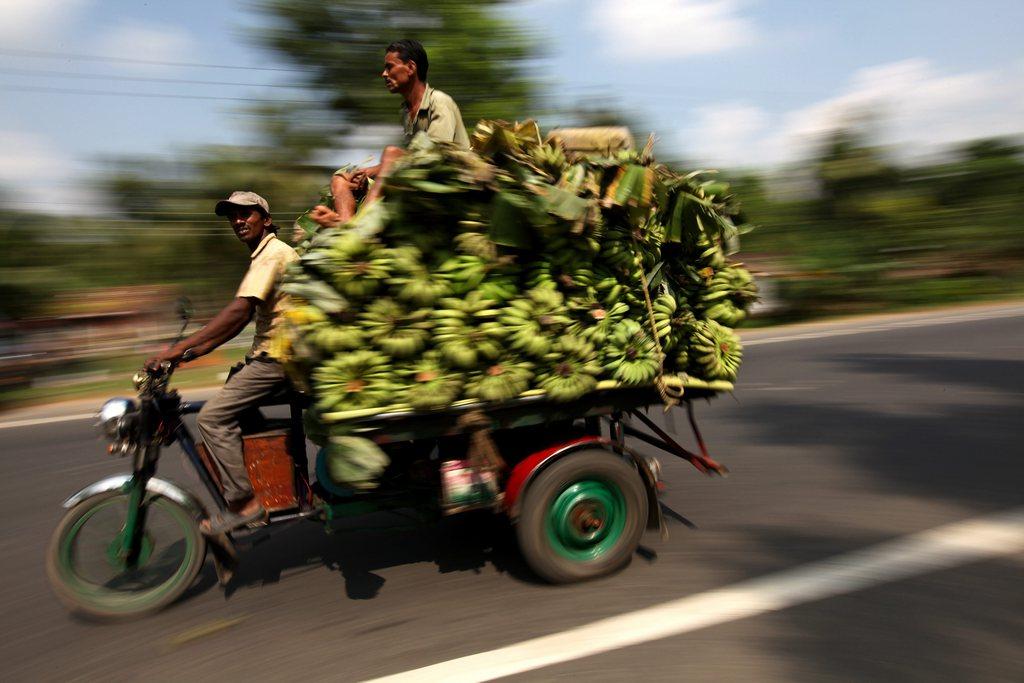Why bananas could be the fabric of the future

Cotton is the king of natural fibres, but its large water footprint can create problems in areas where it’s grown. Can Swiss experiments with fibres from banana stem, nettle, wood or flax offer better alternatives?
India is one of the world’s largest cotton producers and exporters. However, the Cotton Association of India has been in a bit of a bind this year. It has already had to lower its cotton yield estimate for the 2018-2019 season three timesExternal link, always because of lack of water. Drought-like conditions in parts of India have even forced farmers to uproot their crops to preserve what little moisture remains in the soil.
“The water consumed to grow India’s cotton exports in 2013 would be enough to supply 85% of the country’s 1.24 billion people with 100 litres of water every day for a year. Meanwhile, more than 100 million people in India do not have access to safe water,” states an article in The Guardian newspaperExternal link.
Bananas also present a dilemma for Indian farmers, but for a different reason. The part of the plant that bears the fruit, known as the pseudostem, has to be removed after each harvest. The removal process that costs farmers around INR8,000-10,000 (CHF112-140) per hectare. India is the world’s largest banana producer, but most of the fruits are consumed domestically.
Swiss innovation
A projectExternal link at the Lucerne University of Applied Sciences in Switzerland is researching ways to convert the banana pseudostem into yarn that can be used in clothing, aiming to make a more sustainable material.
“The main selling point is that unlike cotton, banana fibre is a waste product,” says project leader Tina Moor. “The objective of our project is to make prototype textiles to show companies and generate interest.”
Textile designers normally start with yarn, but in this case it was up to them to produce it. When the Lucerne team visited India, they found that the Navsari Agricultural University in the state of Gujarat was experimenting with making fibres but did not have any yarn available. Moor tried to get jute mills in India to make yarn from the fibre, but they were not interested.
“I took 40 kilos of banana fibres from India to Switzerland and tried to work with it,” says Moor.
After much trial and error, Moor managed to develop a spinning process from the core of the banana stem that yielded a fine and beautiful yarn. She then made fabric samples from the yarn and hopes to show them off to retailers at a textile expo in March.
“There is interest, but people want large quantities of yarn,” she says, arguing that it is better for the entire process to take place in India where there is an abundant supply of raw material.
Her vision involves a two-tier banana production set up for India to profit from its banana waste. The coarser parts of the pseudostem could be used to make fibres that would be spun into yarn at existing jute mills and used to make carpets or upholstery fabric. The core of the pseudostem could be spun by farming families on a handloom and used to make luxury fabric for the apparel industry.
Exotic options
Banana is not the only cotton alternative the Swiss textile industry is testing. Swicofil, a fibre and yarn company based near Lucerne, offers nettle yarn to clothing companies looking for something different.
“It is not sold on every street corner,” says company CEO Beda Ricklin. “Nettle is a sustainable natural fibre as no fertilisers or pesticides are used.”
The company has temporarily stopped production as its supplier in Nepal was affected by the earthquake of 2015. But it continues to offer other exotic cotton alternatives like fibres and yarn made of banana, hemp, bamboo and chitosan (shells of crabs and shellfish).
But few of the recently developed cotton alternatives have been incorporated into large clothing lines. One of the more successful fibres is Tencel, a material made from wood that was developed in Austria. Swiss clothing company Calida has incorporated it into its collection.
“Tencel as a material is very sustainable, which was the main reason why we started working with it. In addition, it has an extremely pleasant texture, so that clothing made from it is extremely comfortable to wear,” a spokesperson for Calida told swissinfo.ch.
It took the company almost a year to develop their first products with Tencel when it began the process around eight years ago. Getting the texture right is not the only challenge. Trained sales staff, blogs and social media had to introduce customers to the idea of wearing a new type of fabric.
King cotton
Despite their potential, exotic natural fibres will not be replacing cotton anytime soon. Around 40% of the textile market share is occupied by natural fibres. Cotton alone accounts for 30% of the total market share. Therefore, sustainability in the textile business hinges on producing cotton in an environmentally-friendly manner. Organic cotton is one option, since the dilution volume (the volume of water required to assimilate the harmful effect of pesticides and fertilisers) is believed to account for almost 20% of cotton’s water consumptionExternal link.
“Organic soils have a higher carbon content in general, which increases the water capacity of the soil and therefore helps in drought resistance,” says Claudia Keller of Swiss-based Remei, which helps companies source organic cotton.
The Swiss supermarket chain Coop is one of their clients and the second-largest seller of organic fair-trade cotton garments worldwide by volume. Remei is also commercialising the cultivation of native breeds like Arboreum or Desi cotton in India that offer a respectable yield under drier conditions.
But to make a difference for the world’s textile producers and consumers, Switzerland must go beyond ensuring best practices are implemented.
“We are too small as a country and industry to reform the global textile business,” says Nina Bachmann of Swiss Textiles, the umbrella organisation of the country’s textile companies. “That’s why international cooperation with research institutes and EU companies is crucial for our companies.”

In compliance with the JTI standards
More: SWI swissinfo.ch certified by the Journalism Trust Initiative













You can find an overview of ongoing debates with our journalists here . Please join us!
If you want to start a conversation about a topic raised in this article or want to report factual errors, email us at english@swissinfo.ch.